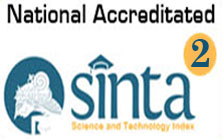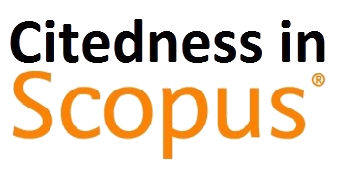The Effect of Flavonoids of Phaleria macrocarpa Fruit Extract on Aortic Diameter Mice Menopause Model
DOI:
https://doi.org/10.31965/infokes.Vol22.Iss2.1554Keywords:
Menopause, Phaleria macrocarpa, DiameterAbstract
Menopause is a phase experienced by women with an age range of 45-55 years. Menopause is a condition where menstruation stops for a minimum of 12 consecutive months due to the decline in ovarian function, leading to a reduction in estrogen levels. A decrease in estrogen can lead to impaired fat metabolism resulting in atherosclerosis. This study aimed to illustrate the influence of flavonoid extract derived from Phaleria Macrocarpa on the enlargement of the aorta's diameter of mice with a menopause condition. The method of this study is a genuine experimental laboratory setting with a research design of a Randomized Post Test Only Control Group setting. Using 32 female mice divided into 6 groups: K- (without ovariectomy and flavonoid extract Phaleria Macrocarpa), K + (ovariectomy without treatment), P1 (ovariectomy + dose 3.75 mg/mice/day), P2 (ovariectomy + dose 7.5 mg/mice/day), P3 (ovariectomy + dose 11.25 mg/mice/day), and P4 (ovariectomy + dose 15 mg/mice/day). Administration of flavonoid extract Phaleria Macrocarpa was carried out for 14 days. Data analysis using statistical analysis. The results showed that in a post-hoc test, namely the administration of Phaleria macrocarpa flavonoid extract at a dose of 11.25 mg/mice/day and 15 mg/mice/day showed that it could increase the dilation of the aortic diameter of mice model menopause. The study concludes that the flavonoid fruit extract from Phaleria Macrocarpa has the ability to increase the width of the aorta in mice with a menopause condition. In future studies, it is recommended to investigate various variables in order to identify the factors that contribute to the narrowing of the aorta. Additionally, it is suggested to perform further research specifically focusing on women going through menopause.
Downloads
References
Ahmad, R., Mazlan, M. K. N., Aziz, A. F. A., Gazzali, A. M., Rawa, M. S. A., & Wahab, H. A. (2023). Phaleria macrocarpa (Scheff.) Boerl.: An updated review of pharmacological effects, toxicity studies, and separation techniques. Saudi Pharmaceutical Journal, 31(6), 874-888. https://doi.org/10.1016/j.jsps.2023.04.006 DOI: https://doi.org/10.1016/j.jsps.2023.04.006
Bacciottini, L., Falchetti, A., Pampaloni, B., Bartolini, E., Carossino, A. M., & Brandi, M. L. (2007). Phytoestrogens: Food or drug? Clinical Cases in Mineral and Bone Metabolism, 4(2), 123–130. https://doi.org/10.1201/b14631-25
BPS. (2017). Badan Pusat Statistik. Jakarta: Badan Pusat Statistik.
Fitriana, S., Andarini, S., Sutrisno, S., Nawangtantrini, G., & Maharani, M. (2023). Hepatotoxicity Oral Administration of Flavonoids Rich Extract from Phaleria Macrocarpha in Mice. Asian Journal of Health Research, 2(2), 36-41. https://doi.org/10.55561/ajhr.v2i2.109 DOI: https://doi.org/10.55561/ajhr.v2i2.109
Forslund, L. C., & Andersson, H. C. (2017). Phytoestrogens in foods on the Nordic market: A literature review on occurrence and levels. Denmark: Nordic Council of Ministers. Retrieved from https://books.google.co.id/books?hl=en&lr=&id=r8o1DwAAQBAJ&oi=fnd&pg=PA1&dq=Forslund,+L.+C.,+%26+Anderson,+H.+C.+(2017).+Phytoestrogens+in+foods+on+the+Nordic+market.+&ots=xCZLacz6aP&sig=LN-7rUhkv7Dxp7vQPr8aQ6T7O3A&redir_esc=y#v=onepage&q&f=false
Goldštajn, M. Š., Mikuš, M., Alberto, F., Mariachiara, F., Stefano, B., Noventa, M., Török, P., Terzic, S., Simone, A., & Simone, L. (2023). Effects of transdermal versus oral hormone replacement therapy in postmenopause : a systematic review. Archives of Gynecology and Obstetrics, 307(6), 1727–1745. https://doi.org/10.1007/s00404-022-06647-5 DOI: https://doi.org/10.1007/s00404-022-06647-5
Halim, R. M., Kamisah, Y., Aziz, N. F., Sudirman, U. N., Ahmad, N. A. N., Yong, C. K., & Zainalabidin, S. (2021). S-Allylcysteine Supplementation Effects on Vascular and Bone Health in Ovariectomized Wistar Rats. Pakistan Veterinary Journal, 41(4), 507–512. https://doi.org/10.29261/pakvetj/2021.118
Hasanah, M., Bahri, S., & Merta, I. W. (2020). Effect of Red Bean Extract (Phaseolus vulgaris, L) on the Development of Female Mice Eggs (Mus musculus) Balb/C strains. Jurnal Penelitian Pendidikan IPA, 6(2), 227-231. https://doi.org/10.29303/jppipa.v6i2.390 DOI: https://doi.org/10.29303/jppipa.v6i2.390
Hopper, S. E., Cuomo, F., Ferruzzi, J., Burris, N. S., Roccabianca, S., Humphrey, J. D., & Figueroa, C. A. (2021). Comparative study of human and murine aortic biomechanics and hemodynamics in vascular aging. Frontiers in physiology, 12, 746796. https://doi.org/10.3389/fphys.2021.746796 DOI: https://doi.org/10.3389/fphys.2021.746796
Javadifar, A., Rastgoo, S., Banach, M., Jamialahmadi, T., Johnston, T. P., & Sahebkar, A. (2021). Foam cells as therapeutic targets in atherosclerosis with a focus on the regulatory roles of non-coding RNAs. International Journal of Molecular Sciences, 22(5), 1–27. https://doi.org/10.3390/ijms22052529 DOI: https://doi.org/10.3390/ijms22052529
Kattoor, A. J., Goel, A., & Mehta, J. L. (2019). LOX-1: regulation, signaling and its role in atherosclerosis. Antioxidants, 8(7), 218. https://doi.org/10.3390/antiox8070218 DOI: https://doi.org/10.3390/antiox8070218
Khatana, C., Saini, N. K., Chakrabarti, S., Saini, V., Sharma, A., Saini, R. V., & Saini, A. K. (2020). Mechanistic insights into the oxidized low‐density lipoprotein‐induced atherosclerosis. Oxidative medicine and cellular longevity, 2020(1), 5245308. https://doi.org/10.1155/2020/5245308 DOI: https://doi.org/10.1155/2020/5245308
Khoudary, S. R. El, Venugopal, V., Manson, J. E., Brooks, M., Santoro, N., Black, D. M., Harman, M., Hodis, H. N., Brinton, E. A., Miller, V. M., Taylor, H. S., & Budoff, M. J. (2020). Heart Fat and Carotid Artery Atherosclerosis Progression in Recently Menopausal Women: Impact of Menopausal Hormone Therapy. The KEEPS Trial. 27(3), 255–262. https://doi.org/10.1097/GME.0000000000001472.Heart DOI: https://doi.org/10.1097/GME.0000000000001472
Kuhnle, G. G. C., Dell’Aquila, C., Aspinall, S. M., Runswick, S. A., Joosen, A. M. C. P., Mulligan, A. A., & Bingham, S. A. (2009). Phytoestrogen content of fruits and vegetables commonly consumed in the UK based on LC-MS and 13C-labelled standards. Food Chemistry, 116(2), 542–554. https://doi.org/10.1016/j.foodchem.2009.03.002 DOI: https://doi.org/10.1016/j.foodchem.2009.03.002
Li, D., & Mehta, J. L. (2009). Intracellular signaling of LOX-1 in endothelial cell apoptosis. Circulation Research, 104(5), 566-568. https://doi.org/10.1161/CIRCRESAHA.109.194209 DOI: https://doi.org/10.1161/CIRCRESAHA.109.194209
Macpherson, B. E., & Quinton, N. D. (2022). Menopause and healthcare professional education: a scoping review. Maturitas, 166, 89-95. https://doi.org/10.1016/j.maturitas.2022.08.009 DOI: https://doi.org/10.1016/j.maturitas.2022.08.009
Maharani, M., Lajuna, L., Yuniwati, C., Sabrida, O., & Sutrisno, S. (2021). Phytochemical characteristics from P.macrocarpa and its inhibitory activity on the peritoneal damage of endometriosis. Journal of Ayurveda and Integrative Medicine, 12(2), 229–233. https://doi.org/10.1016/j.jaim.2020.06.002 DOI: https://doi.org/10.1016/j.jaim.2020.06.002
Maharani, M., & Sutrisno, S. (2021). Pengaruh Flavonoid Ekstrak Mahkota Dewa (P. macrocarpa) Terhadap Peningkatan Indeks Apoptosis Pada Peritoneal Mencit Model Endometriosis. Jurnal Kebidanan Malahayati, 7(4), 652–657. https://doi.org/10.33024/jkm.v7i4.4606 DOI: https://doi.org/10.33024/jkm.v7i4.4606
Moiety, F. M., Salem, H. A., Mehanna, R. A., & Abdel-Ghany, B. S. (2015). Comparative study on induction and effects of surgical menopause in a female rat model: a prospective case control study. International journal of clinical and experimental medicine, 8(6), 9403–9411.
Nayak, T., Freaney, P. M., & Maganti, K. (2022). Atherosclerotic Cardiovascular Disease Risk Assessment and Menopause: Current Evidence. American College of Cardiology. Retrieved from https://www.acc.org/latest-in-cardiology/articles/2022/04/18/12/39/atherosclerotic-cardiovascular-disease-risk-assessment-and-menopause
Newson, L. (2018). Menopause and cardiovascular disease. Post Reproductive Health, 24(1), 44–49. https://doi.org/10.1177/2053369117749675 DOI: https://doi.org/10.1177/2053369117749675
Pratiwi, M., & Damayanty, A. E. (2020). Pengaruh Pemberian Susu Kedelai (Glicine max L. merr) Terhadap Kadar HDL Dan LDL Pada Wanita Menopause (Studi Pada Ibu - Ibu Pengajian Aisyiyah Ranting Melati Medan, 4(4), pp. 132–137. DOI: https://doi.org/10.30596/jih.v1i1.4540
Rodríguez-Landa, J. F. (2022). Considerations of timing post-ovariectomy in mice and rats in studying anxiety-and depression-like behaviors associated with surgical menopause in women. Frontiers in Behavioral Neuroscience, 16, 829274. https://doi.org/10.3389/fnbeh.2022.829274 DOI: https://doi.org/10.3389/fnbeh.2022.829274
Sargowo, D. (2015). Disfungsi Endotel. Malang: UB Press. Retrieved from https://www.google.co.id/books/edition/Disfungsi_Endotel/t0JRDwAAQBAJ?hl=id&gbpv=1&dq=sindrom+koroner+akut+adalah&printsec=frontcover
Simanjuntak, K. (2012). Peran antioksidan flavonoid dalam meningkatkan kesehatan. Bina Widya, 23(3), 135-140.
WHO. (2022). Menopause. World Health Organization. https://www.who.int/news-room/fact-sheets/detail/menopause
Wu, M. Y., Li, C. J., Hou, M. F., & Chu, P. Y. (2017). New insights into the role of inflammation in the pathogenesis of atherosclerosis. International journal of molecular sciences, 18(10), 2034. https://doi.org/10.3390/ijms18102034 DOI: https://doi.org/10.3390/ijms18102034
Yuliawati, D., & Astuti, W. W. (2021). Efek Glycine Soja Terhadap Angiogenesis dan Histologi Aorta Tikus Ovariektomi. Jurnal Kesehatan Andalas, 9(4), 392. https://doi.org/10.25077/jka.v9i4.1506 DOI: https://doi.org/10.25077/jka.v9i4.1506
Yulinda, D., Yueniwati, Y., & Nurseta, T. (2014). Vigna unguiculata reduces aortic intima-media thickness and increases aortic diameter and angiogenesis in ovariectomized rats. Journal of Experimental and Integrative Medicine, 4(2), 85-88. DOI: https://doi.org/10.5455/jeim.140414.br.022
Yousefzadeh, N., Kashfi, K., Jeddi, S., & Ghasemi, A. (2020). Ovariectomized rat model of osteoporosis: A practical guide. EXCLI Journal, 19, 89–107. https://doi.org/10.17179/excli2019-1990
Zhu, D., Chung, H. F., Dobson, A. J., Pandeya, N., Brunner, E. J., Kuh, D., Greenwood, D. C., Hardy, R., Cade, J. E., Giles, G. G., Bruinsma, F., Demakakos, P., Simonsen, M. K., Sandin, S., Weiderpass, E., & Mishra, G. D. (2020). Type of menopause, age of menopause and variations in the risk of incident cardiovascular disease: Pooled analysis of individual data from 10 international studies. Human Reproduction, 35(8), 1933–1943. https://doi.org/10.1093/humrep/deaa124 DOI: https://doi.org/10.1093/humrep/deaa124
Downloads
Published
How to Cite
Issue
Section
License
Copyright (c) 2024 JURNAL INFO KESEHATAN

This work is licensed under a Creative Commons Attribution-NonCommercial-ShareAlike 4.0 International License.
Copyright notice
Ownership of copyright
The copyright in this website and the material on this website (including without limitation the text, computer code, artwork, photographs, images, music, audio material, video material and audio-visual material on this website) is owned by JURNAL INFO KESEHATAN and its licensors.
Copyright license
JURNAL INFO KESEHATAN grants to you a worldwide non-exclusive royalty-free revocable license to:
- view this website and the material on this website on a computer or mobile device via a web browser;
- copy and store this website and the material on this website in your web browser cache memory; and
- print pages from this website for your use.
- All articles published by JURNAL INFO KESEHATAN are licensed under the Creative Commons Attribution 4.0 International License. This permits anyone to copy, redistribute, remix, transmit and adapt the work provided the original work and source is appropriately cited.
JURNAL INFO KESEHATAN does not grant you any other rights in relation to this website or the material on this website. In other words, all other rights are reserved.
For the avoidance of doubt, you must not adapt, edit, change, transform, publish, republish, distribute, redistribute, broadcast, rebroadcast or show or play in public this website or the material on this website (in any form or media) without appropriately and conspicuously citing the original work and source or JURNAL INFO KESEHATAN prior written permission.
Permissions
You may request permission to use the copyright materials on this website by writing to jurnalinfokesehatan@gmail.com.
Enforcement of copyright
JURNAL INFO KESEHATAN takes the protection of its copyright very seriously.
If JURNAL INFO KESEHATAN discovers that you have used its copyright materials in contravention of the license above, JURNAL INFO KESEHATAN may bring legal proceedings against you seeking monetary damages and an injunction to stop you using those materials. You could also be ordered to pay legal costs.
If you become aware of any use of JURNAL INFO KESEHATAN copyright materials that contravenes or may contravene the license above, please report this by email to jurnalinfokesehatan@gmail.com
Infringing material
If you become aware of any material on the website that you believe infringes your or any other person's copyright, please report this by email to jurnalinfokesehatan@gmail.com.


















